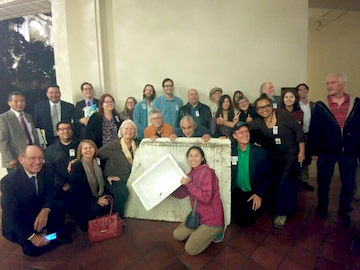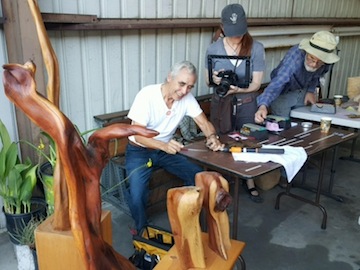|
|

Making
Friends while Banning
’Foam
Good
TO-GO Campaign and
Styro-Free Pasadena
Pasadena
City Council unanimously
approved a ban on polystyrene
food containers on
May 9, 2016!
Michiko Lynch is a
new Transition
Pasadena member and a
Queen of Zero Waste in
her own life. (She's
down front in the
photo.) She brings
Mason jars to the
butcher to put her
meat in, and carries
non-disposable
silverware and food
containers in her car.
She also describes
herself as a
Tree-hugger-hugger,
since her main
squeeze, John Lynch,
is an arborist.
Michiko inspired several
Transition members and
other Eco Activists in
our community to launch
the Good To-Go Campaign,
part of ongoing efforts
to ban Styrofoam
containers. A group
effort led to the
creative name and logo,
a vibrant social media
campaign, stickers,
petition signatures
mounting to the
hundreds, plus many
personal letters to
council and a formal
letter signed by 20
local organizations,
businesses, and faith
groups.
We didn't accomplish
this alone; we connected
with many new and old
friends along the way.
And we owe thanks to all
the volunteers and
supporting citizens
including: Styrofoam
Free Pasadena, Day One,
Arroyo Seco Foundation,
Arroyos and Foothills
Conservancy, Altadena
Heritage, Arroyo Food
Co-op, All Saints Church
Sustainable World
Ministry,
Pasadena-Foothills
Chapter of Citizens
Climate Lobby, La Loma
Development/The Shed,
Neighborhood Church
Green Council, Pasadena
Audubon Society,
Pasadena Group - Los
Angeles Chapter of the
Sierra Club, Throop UU
Church, Waste Less
Living, Zanja Madre,
Repair Café Pasadena,
Throop Learning Garden,
Mulch for the People,
and
Coloradoboulevard.net.
We also thank: Pasadena
City Council, the Staff
of the Department of
Public Works, and the
Environmental Advisory
Commission.
We are determined to
keep this momentum
going!
- We are building
and strengthening
relationships with
our newly
invigorated local
Eco Activists Group.
- We will remain
vigilant. We will
not allow the
drafted ordinance
veer off of a path
to adoption.
- We also support
the citizens of
other San Gabriel
Valley and Foothills
communities who want
to ban polystyrene.
- And we support a
“Yes” vote this
November to keep the
statewide plastic
bag ban.
As Michiko says, "I have
found my people!"
— Therese Brummel
|

Free-Food
Plants Have a New Home
Free-Food
Garden (formerly at
Arroyo Food Co-op)
Originally envisioned by
Sylvia Holmes and a
small group of co-op and
community members back
in 2013, the Free-Food
Garden became a
flourishing hub of
plants and public space.
Native plants placed
along the parking strip
completely filled in the
space, mounding
beautifully and covered
with flowers. The three
fruit trees adjacent the
co-op had grown taller
than the gardeners who
tended them, and many
veggies and small fruit
filled in around the
trees, ready to be
picked by neighbors and
passers-by.
Alas, the lease on the
building has run out,
and the Arroyo Food
Co-op is moving on. So
what of the garden?
It’s spring, a time of
renewal.
And so, Sylvia reached
out to Lamar Anderson,
the president of the
garden leadership
council at Villa Verde
Rooftop Garden at
Villa-Parke, and asked
him to visit and survey
the garden. He agreed to
relocate the trees and
plants to the park
garden plots, and
recruited volunteers for
the challenging
eight-block move.
There was a fond
farewell gathering for
Free-Food Garden fans to
meet, express themselves
with chalk drawings on
the pavement, and
exchange food from their
home gardens, and share
memories of the good
times at the Garden.
Sylvia briefed the Villa
Verde team on how to
transplant the trees.
They dug out the Pixie
Mandarin and Fuyu
Persimmon, wrapped each
root ball in a tarp, and
settled the trees into a
pickup truck. Team
member Alicia comforted
the trees en route to
the Villa Verde Rooftop
plots, where again free
food will be available
just as it was at the
Free-Food Garden. When
Sylvia brought worm
castings for the plants
in their new beds, she
said she felt like she
was visiting a family
member in the hospital
or adjusting to her
children’s leaving home.

As for the native
plants, since it is not
the right season to
plant natives, Roger
Klemm, founder of
Sunland Welcome Nature
Garden who originally
provided the natives,
will take cuttings and
propagate a new
generation for the
Rooftop garden.
Kudos to Sylvia Holmes
for imagining and
creating a warm and
welcoming place, the
Free-Food Garden, to
bring people together in
Pasadena, and for making
sure that the legacy of
this garden continues
on! Be sure to visit the
plants after they have
settled in at their new
home at Villa-Parke!
— Lin Griffith &
Qrys Cunningham
Free
Food Garden at Arroyo
Food Co-op
|

Throop
Learning Garden
Sundays
— 8:30 am to 10:30 am
Throop Memorial
Church
300 S. Los Robles
Ave., Pasadena
We are preparing a
series of workshops on
compost, hypertufa
constructions for the
garden, canning,
pickling, and backyard
produce preserving. We
plan on constructing a
Three Sister garden
using a waffle technique
in the first part of
June. We are also
planning a couple of
family friendly events.
Stay tuned for dates.
We meet Sundays from
8:30-10:30am. Come join
us!
Notes From the
Garden
The San Gabriel Chapter
of the California Native
Plant Society hosted Dr.
Stephen Davis, plant
ecologist from
Pepperdine University,
at its May meeting. Dr.
Davis presented a talk
on the extended drought
and its effects on
California chaparral.
His research involved
two “bookend” species
essential to the healthy
functioning of the
chaparral ecosystem:
Laurel Sumac and Bigpod
Ceanothus. These plants
were chosen as the two
plants with the most
hearty comeback
potential after fire.
Laurel Sumac has
incredibly deep roots
that persist after fire,
allowing the plant to
send up suckers after
the main trunk has been
burned. Bigpod Ceanothus
seeds break open during
fire, so seeds can
germinate post fire.
Both are survivor
species. Laurel Sumac
may have roots as deep
as 42’, allowing the
plant to tap in to deep
water resources. Bigpod
Ceanothus Has great
capacity for
withstanding dehydration
during drought times.
Both have survivied for
thousands of years.
But now we face the
special challenges of
climate change. Most
droughts in California
since the Pleistocene
endured for 20 years or
less. Occasionally
droughts of 30-100 years
were recorded. During
these times normal air
temperatures prevailed.
Currently we are
experiencing the mean
temperature creepin, and
in some cases, leaping
in ways we have never
experienced. Coupled
with the lack of
rainfall, Dr. Davis and
his students have
noticed a dramatic shift
in the response of the
bookend species.
Laurel Sumac has been
attacked throughout the
Malibu area by a fungus
that usually lives
commensurately with the
plant. This is causing
cankers to form
throughout the plant
that thwart the rise of
water from roots to
stems, thus stressing
the plant and ultimately
killing it.
Bigpod Ceanothus has
relatively shallow roots
(+-5’). During drought
it dessicates readily,
sending its energy into
the main stem of the
plant. If it dessicates
too far it has the
effect of splitting the
bark, allowing air into
flow passages,
essentially creating a
plant embolism. The
plant dies back, unable
to deliver fluid to all
its parts. Also the
seeds have been
germinating not from hot
fire followed by rain,
but by increased soil
temperature followed by
hot, dry weather. In the
current situation the
seed sprouts only to be
dried out and killed.
Dr. Davis and his
students are documenting
a phenomenon never
witnessed before. Their
area of study is an area
in Malibu that burns
every 7 years or so.
Nonetheless he concludes
that our chaparral
landscape is in big
trouble from climate
change and extended
drought.
For more information:
http://seaver-faculty.pepperdine.edu/davis/
— January Nordman
Throop
Learning Garden
|

Repair
Cafe Pasadena
Villa
Parke Auditorium (with
Pop-Up Museum!)
Saturday, June 4 —
10:00 am to 1:00 pm
Villa Parke
Auditorium
363 E. Villa St.,
Pasadena
Along with
tinkerers and tailors
and tool sharpening,
June's uniquely
festive free event
will have a bike
repair station!
Patrons can give back
by helping the Hill
Street Library's Seed
Library package and
label seeds for free
giveaway while they
wait for repairs.
Michiko, our Zero
Waste queen will be
converting a Mason jar
to a drink container
by punching a hole in
the lid for a zero
waste straw. And there
will be a surprise
Pop-Up Museum, a
creative, spontaneous
experience focused on
one topic.
There will be
seedlings to share,
garden advisors, the
Really, Really Free
Market, and free
coffee compliments of
Charlie's Coffeehouse
in South Pasadena.
— Therese Brummel
Repair
Café Pasadena
|

Grace and
Community
A few weeks back I was
privileged to attend an
Earth Holders retreat at
Thich Nhat Hanh’s Deer
Park Monastery. The
retreat focused on a
Buddhist response to
climate change.
One dharma talk sounded
a chord of understanding
for me. The young sister
giving the talk
described how clues to
the answer to an issue
may lie in our language.
An example of this is
the word “earth”. The
letters used in “earth”
can be reordered to
spell “heart”. This
seemed a silly parlor
trick, clever, but of no
consequence. I became
less attentive.
Then the sister turned
to two concepts:
- ill will and well
being
- the cause of
suffering and the
end of suffering.
She broke this down
further to “ill” and
“well”. What causes
suffering and what
releases one from
suffering? Remove the Ls
from these words and one
is left with “I” and
“WE”. My attention
returned with an aha
moment!
When humans focus on
ill-will; like greed,
avarice, hatred,
injustice, or more
concretely; gossip,
bullying, disrespect, or
coercion, they become
isolated and bring
suffering to themselves
and their community.
They eschew grace for
superficial transitory
power or short term
gain. This is the
underbelly of “I”.
When humans can define
themselves as “I” as
part of “WE” they move
beyond isolation of self
to the grace of
recognizing
interconnection and
interdependence. Humans
are social beings, in
need of interaction,
love, and kindness from
a family, tribe, or
community.
But how does this relate
to climate change?
As humans, our corporal
being consists of about
50% human cells and 50%
other-bacteria, and
other single cell
organisms, without which
we could not function.
We inter-are with these
beings that live in and
on us. Awareness of this
brings a new sensibility
to the concept of
community. If we
inter-are within our
bodies, could we also
have the same type of
relationship outside our
bodies?
We breathe in
microscopic organisms,
oxygen, and dust with
each breath. We are
intrinsically linked to
all life by this simple,
automatic action. The
trees in the forest
exude oxygen that allows
us to live and thrive.
We breathe out CO2 which
the trees inhale and
thrive. This primordial
balance illustrates how
we interact with every
organism on our
beautiful planet. We
exchange energy,
nutrients, cycles, and
consciousness with all
beings through complex
and often, indirect
means. The awareness of
this endless stream of
interactions and
dependencies is grace.
It is the foundation for
healing ourselves and
our relationship to our
planet. Without this our
attempts at altering
climate change are
fear-based and
mechanistic, and doomed
from reaching a
wholistic resolution.
By embracing the concept
of inter-being we open
our hearts and minds to
altering our intentional
interactions with the
world around us. Each
individual act can be
magnified when combined
in the we through
respect, honor, and
love.
A starting point is a
simple loving kindness
meditation. Please
soften the focus of your
eyes and breathe deeply
3 times at each
contemplation:
1- May I be peaceful,
healthy and aware
2- May you be peaceful,
healthy and aware
3- May Earth be
peaceful, healthy and
aware
4- May we be peaceful,
healthy and aware
— January Nordman
|
|
Published on June 1,
2016
Editor's Note: There
was no newsletter in
May.
|
|
|
|
|
|
|
|